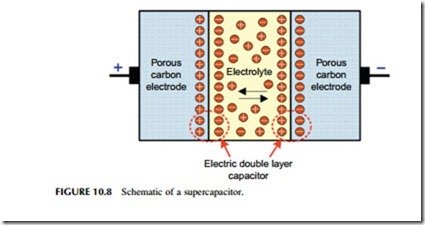CAPACITORS
Capacitors are electrical or electronic devices that store energy in the form of electrostatic charge. The simplest capacitor comprises two metal plates separated by a small air gap so that no current can pass between them. When a
voltage is applied across it the plates become statically charged and this charge can later be released by creating a short circuit between the plates.
Capacitors of various sorts are key components of electrical and electronic circuitry, particularly when creating tuned circuits. While blocking DC current they will allow an AC current to pass with an amplitude that is inversely pro- portional to the frequency. However, conventional capacitors are capable of storing only a limited quantity of electrical energy. Since the end of the 1970s a new type of capacitor has been available, called an electrochemical capacitor, and these can store much larger quantities of energy. These capacitors, which have names like supercapacitors or ultra-capacitors, are based on electrochemical processes that are similar to those in batteries.
Energy Storage Capacitor Principles
A simple electrostatic capacitor comprises two plates with an air gap between them. When a voltage is applied to the plates, charge builds up on them to neutralize the voltage by creating an equal and opposite static-charge voltage across the plates. The charge will continue to build as the voltage is increased until it is high enough to cause air to breakdown and start conducting electricity.
The amount of charge the capacitor will hold can be increased by placing a dielectric material between the plates that reduces the strength of the field between the plates, allowing more charge to build up before breakdown occurs. An electrochemical capacitor is similar to this in that it has a dielectric material between the capacitor plates, but in this case the dielectric is a liquid electrolyte such as sulfuric acid or potassium hydroxide (Figure 10.8). The capacitor plates themselves are inert materials that will not react with these reagents.
When a charge is applied to the capacitor it causes the usual charge buildup. However, in this case the charge on each plate is neutralized by an opposing layer of charged ions from the electrolyte. This creates a double layer of charge
at each plate, effectively leading to two capacitive charged layers, which massively increases the amount of charge the unit can hold.
The simplest electrochemical capacitors use a water-based electrolyte, which restricts the voltage that each can support to around 0.9 V before electrolysis of the water begins. This limits the amount of charge the capacitor can hold but otherwise these capacitors have excellent characteristics. Basic capacitors of this type (known as symmetrical capacitors) have two identical electrodes made from carbon. By varying the construction of one electrode, it is possible to increase the amount of energy the device can hold. Devices of this type are called asymmetrical capacitors. A second type of electrochemical capacitor uses an organic electrolyte, which allows it to support a voltage up to 2.7 V. Both symmetrical and asymmetrical versions of these capacitors are available too. Since single capacitors of either type can only support a relatively low voltage (in grid terms), electrochemical capacitors are usually stacked in series to allow higher voltages to be exploited.
Performance Characteristics
Electrochemical capacitors can be cycled for tens of thousands of times without degradation provided the voltage across them is kept below the maximum so that no internal reaction takes place. However, once they are charged they do lose charge slowly through leakage in the same way as a battery. The leakage levels in water-based electrochemical cells are similar to those of a lead-acid battery. Leakage levels are lower with organic-based electrolytes.
Leakage will reduce long-term storage life, but with fast cycling, roundtrip efficiency can be 95% or higher. In addition, capacitors can normally discharge their energy very rapidly without damage so long as excessive internal heating is avoided. Energy density is moderate between 1 Wh/kg and 5 Wh/kg for symmetrical capacitors and up to 20 Wh/kg for asymmetrical capacitors. In comparison, a lead-acid battery has an energy density up to 42 Wh/kg. Response time is fast at 5 msec.
Units can be designed with the capability to deliver power levels between 1 kW and 5 MW, but actual energy storage capacity is generally relatively low at 1–10 kWh. When power is withdrawn from a capacitor the voltage falls, so sophisticated DC–AC conversion systems are needed to maintain a constant voltage output.
Applications
Electrochemical capacitors have been used both for energy storage and for braking energy recovery systems in automotive applications. For grid use they are best suited to backup or fast reaction grid support, offering a similar performance to flywheels. Although capacitors are not yet widely deployed for grid support they have been tested in a number of configurations. These include adding rapid-response storage to small distributed generation grids or micro- grids where they can provide fast-reacting grid support when the output from intermittent renewable resources suddenly falls and before a backup engine– based system can take over. Capacitors are also being tested for high-voltage grid support services.
Costs
The cost of capacitor storage is likely to be similar to that for flywheels at around $2000/kW. Based on cost per unit of energy storage, the price is again expected to be similar to that of flywheels with costs from $7000/kWh to per- haps $1million/kWh depending on the size of the unit. As with flywheels, this reflects the use of this in low storage capacity, high power output configurations for rapid, short-duration delivery of power.
